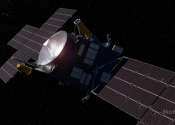Student's comparative analysis of primitive asteroids provides context for further research, future NASA missions
The primitive asteroids that UCF physics doctoral student Brittany Harvison studies carry with them traces of their origins and billions of years of our solar system's history.







